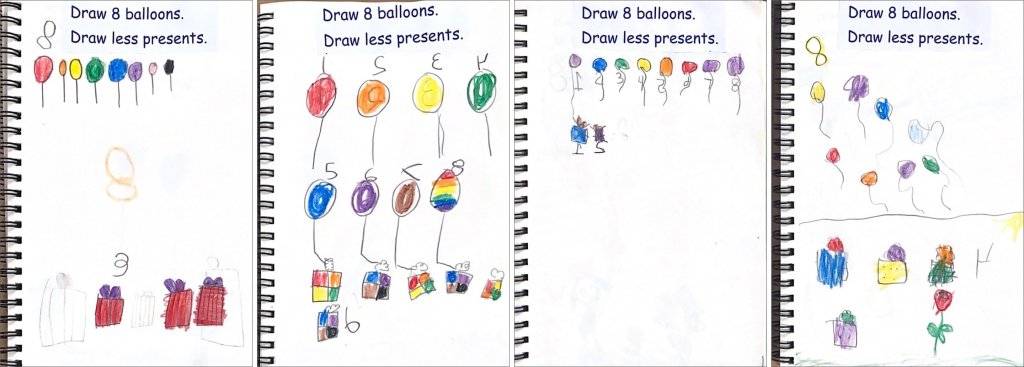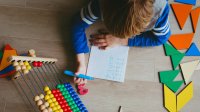Using Math Journals in Kindergarten to Deepen Students’ Understanding
Journal prompts with multiple entry points allow teachers to differentiate instruction for young learners.
Your content has been saved!
Go to My Saved Content.Math journals will look different depending on whose classroom you are walking into. Some colleagues use math journals as a place for students to record problem-solving strategies before sharing out with peers. Others use math journals as a place for students to reflect on their learning or to synthesize the lesson objectives as a form of note-taking.
The benefits of including writing in the math classroom have been proven, and math journals provide opportunities for students to explain, justify, and prove their mathematical thinking through writing and illustrations.
Journals can also support equity-based mathematics practices—especially when journal prompts have multiple-solution strategies and entry points. In our kindergarten classroom, where students may not have developed the same language or writing skills as some of our older students, we use prompts that invite students to see math in their everyday lives and to illustrate situations that lead to deeper conversations and connections.
What Do Math Journals Look Like in Kindergarten?
Over the past two years, our kindergarten math journals have been a way to capture students’ understanding and growth over the course of the school year, allowing teachers, families, and students to see their progress. Kindergarten students arrive at school with a wide range of knowledge, interests, and readiness. To meet the diverse needs of a variety of learners, it’s important to provide activities and tasks that allow students to play, discover, and explore while maintaining a high level of cognitive demand.
In our kindergarten classroom, students flow through math centers that include exploratory activities, manipulatives, and/or games. Approximately once a week, one of those centers involves a math journal prompt that connects to the current learning target. Journal prompts are open-ended and offer multiple entry points, allowing all students to start from where they are and feel successful in doing so.
Students are excited to use their journals as a place to draw, write, and express their ideas, and they feel a sense of ownership and pride over these journals. Before the journal is presented, teachers prepare follow-up questions that help push student thinking as needed. Students talk with each other as they work, discussing their ideas and pictures, which helps create a community of learners who view math as more than worksheets and answer getting. Teachers are available to take notes or voice-record as they listen in on conversations to document discoveries and noticings.
What Makes a Good Journal Prompt?
Kindergarten math prompts should be short, be easy to explain, and allow for students to connect math to their lives outside of school. Prompts that could be answered with multiple-solution strategies or allow students to approach the situations in different ways provide opportunities for rich discussions.
Even at this young age, we can see students developing the habits and behaviors of good mathematicians. In these journals, children are using pictures, words, and numbers to make sense of the problem, use what they know, and connect math to their everyday lives (National Council of Teachers of Mathematics Standards for Mathematical Practice MP2 and MP4).
Students might draw pictures or use objects to explain their strategies, especially when the language to do so might not yet be developed (MP3). This type of problem-solving, sense-making, and communication are vital for supporting students’ development as mathematicians.
Journal Examples
The Counting Sequence: One of our math journal prompts at the start of the year is “Write your numbers in order as high as you can go,” which can provide a small window into student thinking and understanding. Teachers are able to look at how students write and organize numbers and track any reversals.
As students write their numbers, they are encouraged to use tools around the classroom, such as number lines, labels, and clocks, to help refer to numbers they may know how to say but not yet write. These moments, in which students make their own discoveries, allow them to feel empowered and have lasting benefits.
Composing and Decomposing Five: As students are learning how to decompose numbers to five, the following math journal prompt allows students to practice this skill: Sara made a train using five snap cubes. She used cubes of two colors. What might the train look like? Draw the train.
Students are presented with snap cubes to explore this task and make discoveries on their own before recording their findings in their journals. As students draw their combinations, follow-up questions include “Are there any other combinations you can make?” and “How do you know you have found them all?”
More and Less: As students are learning how to compare numbers to 10 and use vocabulary such as more and less, we use this journal prompt: Draw eight balloons. Draw less presents. This prompt has led to a lively discussion among the students about how many presents they want to draw as we ask them to prove how they know they have less. As students work on their responses, they discuss how their picture illustrates the prompt and how they know their response is true.

Opportunities for Meaningful Feedback
In addition to documenting progress, journals allow teachers to provide students with meaningful feedback, either written or orally, about their strengths in mathematics. Journals also create a portfolio of work samples, which help families understand what their child is working on in their classrooms and how they are growing and learning over the course of the year. Teachers, parents, and students alike have found math journals to be a wonderful addition to our kindergarten program.
